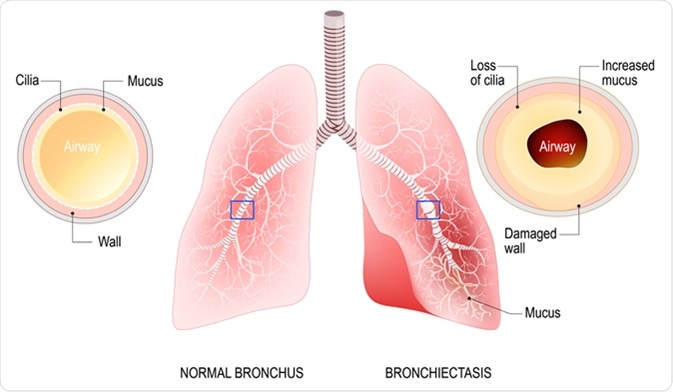Bronchiectasis is a chronic condition of the respiratory system, in which there is abnormal widening of the airways due to an initial damaging factor. This in turn reduces the ability of the bronchi to clear mucosal secretions, thereby leading to an abnormal buildup of mucus. This leads to an increased susceptibility to infections and inflammation that further damage the airways.

There are a number of etiologies, both acquired and congenital, that may lead to bronchiectasis. However, in over 50% of reported cases the cause is classified as idiopathic – there is no known cause or association. Almost any condition that causes damage to the airways may result in the development of bronchiectasis.
Bronchiectasis can occur at any age, although it is more commonly acquired later in life. Moreover, it affects women more than men. While it is still classified as a rare disease, it is growing in prevalence worldwide.

What is the Role of the Immune Response and the Development of Bronchiectasis?
Patients with an inadequate immune response are at a greater risk of developing bronchiectasis as a secondary condition. Allergic bronchopulmonary aspergillosis (ABPA), characterized by hypersensitivity to the fungus Aspergillus, is the cause of 1–10% of cases of bronchiectasis.
Autoimmune diseases of the connective tissue, such as systematic lupus erythematous (SLE), Sjörgen syndrome or rheumatoid arthritis may all lead to an abnormal widening of the bronchi. The damaging factor is the deposition of antigen/antibody complexes in the airways. The resulting clinical outcome will be very varied, but often characterized by a rapid progression.
Inflammatory bowel diseases have been recognized as being associated with bronchiectasis, although the relationship is rare.
What are the Infectious Causes of Bronchiectasis?
Bacterial, fungal and viral infections of the lungs, which had been acquired earlier in life are also common primary causes of bronchiectasis. These include tuberculosis, measles, whopping cough or severe pneumonia. Single-lobe bronchiectasis is the classical presentation, and in cases where there is a history of tuberculosis infection, the upper lobes of the lung are typically infected.
Environmental non-tuberculous mycobacteria (NTM) are increasingly being recognized as a potential cause for bronchiectasis. They include around 150 species that fall in the same family as M. tuberculosis but are not contagious. The source of human infection is the environment.
What Congenital Defects Are Linked to Bronchiectasis?
Some genetic conditions that lead to bronchiectasis include cystic fibrosis, alpha1-antitripsin deficiency, and Marfan syndrome.
Primary ciliary dyskinesia (PCD) is a rare genetic disorder, which results in an impaired function of the cilia lining the mucosal layer. This leads to reduced or absent mucus clearance from the airways, leading to persistent inflammation and infections, which continue in a vicious cycle. Usually recognition and treatment of associated complications is advised, and genetic counselling may also be of help to the patients.
Other Causes of Bronchiectasis
Aspiration of particles that get lodged in the airways can lead to dilation of the bronchi. Foreign body aspiration, gastric content aspiration in GERD (gastroesophageal reflux disease) or inhalation of corrosive substances are some examples. Benign tumors and enlarged lymph nodes can also cause an obstruction of the airways and subsequent damage that will typically lead to single lobe bronchiectasis. In the cases of physical obstruction of the airways, clearing the airways of the obstructive factor by means of bronchoscopy or surgery is done.
Although asthma and bronchiectasis are different conditions, it is not uncommon to find them coexisting in the same patient. Mucus can be retained in the bronchi of patients with asthma, and this in turn may lead to an infection by common pathogens, as well as inflammation that can damage the airways and result in bronchiectasis.
Sources
- NHS: Bronchiectasis https://www.nhs.uk/conditions/bronchiectasis/
- British Lung Foundation: Bronchiectasis https://www.blf.org.uk/support-for-you/bronchiectasis/what-is-it
- American Thoracic Society, Patient Education Information Series, Bronchiestasis www.thoracic.org/…/chapter-4-bronchiectasis.pdf
- JD Chalmers, SH Chotirmall, Bronchiectasis: new therapies and new perspectives, The Lancet Respiratory Medicine, 2018, https://doi.org/10.1016/S2213-2600(18)30053-5
- Contarini M, Finch S, Chalmers JD. Bronchiectasis: a case-based approach to investigation and management. Eur Respir Rev 2018; 27:180016, https://doi.org/10.1183/16000617.0016-2018
Further Reading
- All Bronchiectasis Content
- Bronchiectasis Treatment
- Bronchiectasis Complications
- What is Bronchiectasis?
- Bronchiectasis Symptoms and Diagnosis
Last Updated: Mar 21, 2019
Source: Read Full Article
